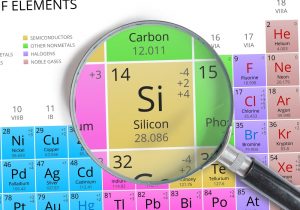 Here at Polymer Solutions, details matter. Our love of great science and highly varied testing services could never exist without a keen eye for details. Often, the smallest–and seemingly simple– differences can result in far-reaching changes between two substances. For instance, two substances that sound very similar in prefix and ending can be widely different and useful in very different applications.
Here at Polymer Solutions, details matter. Our love of great science and highly varied testing services could never exist without a keen eye for details. Often, the smallest–and seemingly simple– differences can result in far-reaching changes between two substances. For instance, two substances that sound very similar in prefix and ending can be widely different and useful in very different applications.
A great example is the distinction between silicon and silicone. From their chemical makeup to everyday applications, these two substances are very important to understand. While they sound similar and are even used in conjunction with each other in certain applications, silicon and silicone perform incredibly different tasks. Today, we’ll explore these two similar-sounding but vastly different substances.
“Silicon”
Silicon is a naturally occurring element. It makes up much of the Earth’s Crust and is a metalloid (number 14 on the periodic table) because it has properties of both metals and nonmetals.
Pure silicon is rarely seen in nature. It’s often bound with oxygen to form silica, or silicon dioxide. If you are a beach-goer, you’ve likely felt silica between your toes–as it is a major component of sand. Its abundance makes it a great building material for a variety applications.
 On top of its usefulness as a building material, silicon is a semiconductor. A semiconductor has a conductivity that falls between the conductivity of a insulator and that of metals. Under some conditions, a semiconductor will conduct electricity–under other conditions it will not. Silicon is the most common material used in integrated circuits and microchips. Because the conductivity of silicon can be controlled in this way, it’s suitable for these applications.
On top of its usefulness as a building material, silicon is a semiconductor. A semiconductor has a conductivity that falls between the conductivity of a insulator and that of metals. Under some conditions, a semiconductor will conduct electricity–under other conditions it will not. Silicon is the most common material used in integrated circuits and microchips. Because the conductivity of silicon can be controlled in this way, it’s suitable for these applications.
When you’re thinking of a computer’s circuit board or the startup-mecca in California, you’re thinking of Silicon.
“Silicone”
Unlike the element silicon, silicone is a synthetic compound made up of siloxanes. Silicone is made of silicon, oxygen, and other elements like hydrogen and carbon. Silicones (there are many) are silicone-oxygen hydrides and very useful for a wide range of applications.
Silicone has a low toxicity and high heat resistance. This makes it a wonderful compound for use in sealants for watertight containers like fish tanks as well as plumbing pipes.
Different applications require silicone to possess various properties. The molecular weight of a silicone controls its viscosity. A high molecular weight silicone is rubbery while a low molecular weight silicone is an oil. Polydimethylsiloxane (PDMS) is a common silicone commonly used for its water-repelling properties–a main ingredient in products in Rain-X. We also use PDMS here at Polymer Solutions as a viscosity standard in testing.
We once had a project to determine why a polyurethane plastic plug would not stick to the metal casing of a propelling charge for a military application. We found out that the manufacturer accidentally used silicone coated silica instead of silica itself. The silicone migrated to the surface of the plastic plug, causing the adhesive to fail. While this would be an advantageous property in some applications, it certainly explained this project’s problem! The simple naming difference can be confusing, even for manufacturers.
The molecular difference between silicon and silicone is merely carbon and hydrogen, in addition to silicon and oxygen. Both are important substances for a variety of applications and can be used in the same product: silicon is used in integrated circuits and silicones can be used to seal those same circuits from water damage and heat because of their helpful physical properties.
Small chemical changes have huge impacts on the physical properties of a substance. Silicon– and silicon dioxide– are a major component of sand. With the simple addition of carbon and hydrogen, those same basic elements form silicone, whose properties make it suitable for a whole new and wide range of applications.
These small details inform so much of our work here at Polymer Solutions. We’re often looking for minute differences or discrepancies at a molecular level. Our understanding and attention to those details allow us to develop tests and act an industry leaders in a world of small differences and complex issues. If you’re looking for testing partner that understands those differences at both fundamental and practical levels, contact us today!
